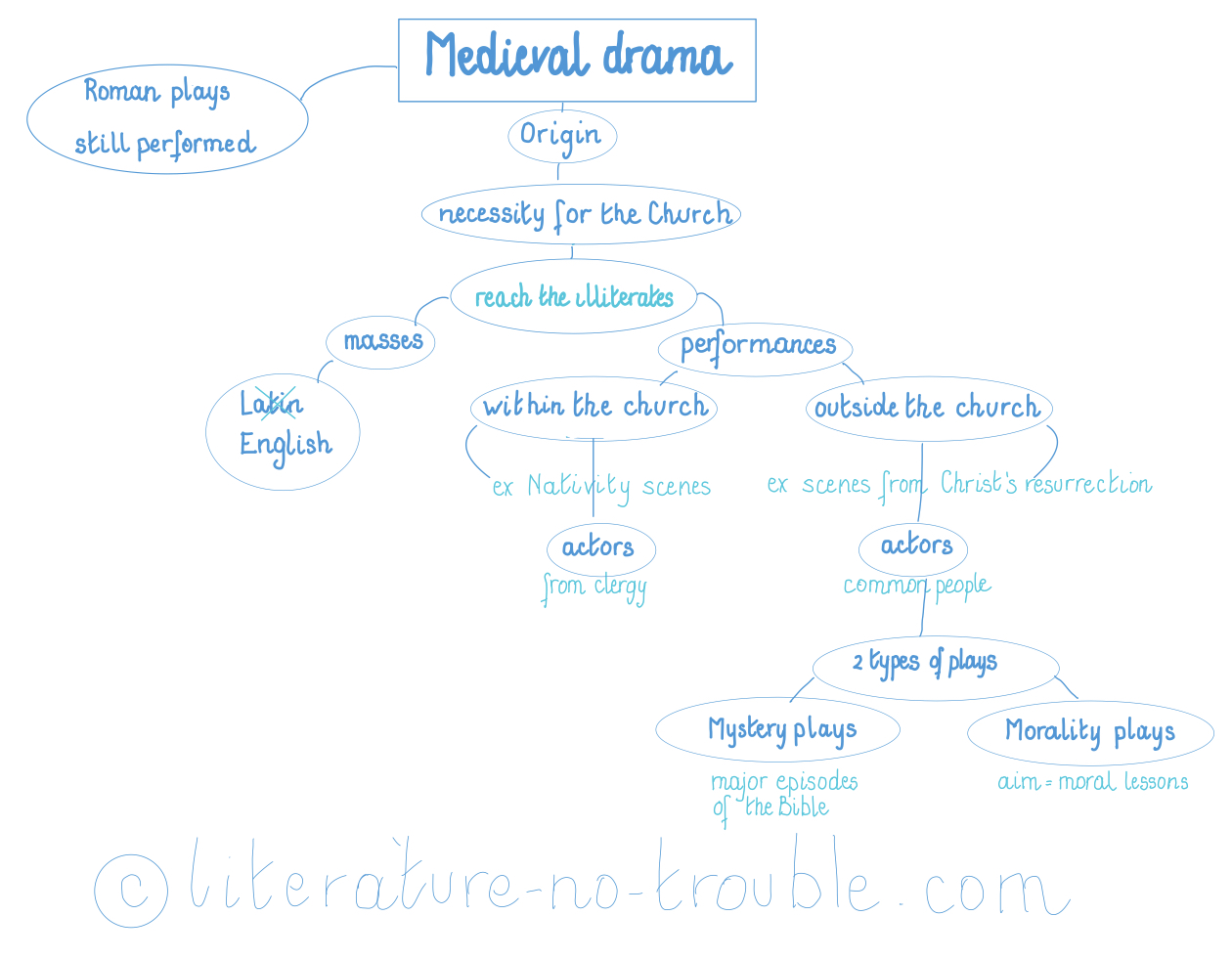Medieval Drama
Find out more about the beginnings and evolution of medieval play by reading about the six components listed below.
- Pageants
- First dramatization during the mass
- Liturgical plays
- Mystery plays
- Morality plays
- Miracle plays
"As Christian Church grew in power, its opposition to the stage became more effective. Plays were prohibited and actors proscribed in city after city throughout the Roman Empire" (A History of English Literature, William Vaughn Moody, chapter 5)
The Roman plays were forbidden long before the Norman conquest, as the Roman empire crumbled and the Christian Church gained power. However, there was no decline in the demand for spectacles. Jugglers, minstrels, and other performers were seen at festival times and on market days (country folk plays, which contributed to the formation of traditional figures such as Robin Hood, Maid Marian, and the Green Dragon). To greet the King or other dignitaries on an official visit, pageants were also held close to the city entrance. Pageants were often elaborate pantomimes with conventional allegorical figures, i.e., spectacular displays with a stunning background.
According to many academics, the regular mass is where mediaeval drama originated. The mass was conducted in Latin, a language that most people could not understand. The Bible was likewise only vaguely understood by the common people. Because of these factors, music and charts made up a considerable section of the service. Painted rolls illustrating the pivotal moments of the Bible stories were also on display because the majority of participants was illiterate.
![An example of pageant by Oscar Kuehn [Public domain]](https://948a74da74.clvaw-cdnwnd.com/71c30834495be23d4e60e2ab24b6cd8c/200000541-d5f9ed5fa0/336D2147-9773-4A61-BFB8-85F324EB0E89_1_201_a.jpeg?ph=948a74da74)
The dramatisation of the services began in the eleventh century. There weren't many additions done at first. The priests then recreated scenes from Christ's life in which they played every part. The churches were unable to accommodate everyone as more episodes and participants were added to these "Liturgical Plays" (in Latin). As a result, the compositions were moved to the churchyard, then to the markets or the city streets.
In Europe, plays that dealt with biblical themes were referred to as "Mystery plays," but plays that depicted the lives of the saints were typically referred to as "Morality plays." This difference is meaningless when discussing English "Liturgical plays," often known as "Miracle plays."
By the 12th century, laymen started filling the clerics' old positions. The trade guilds took over the organisation of the performances when the priests stopped doing so. The plays were still liturgical, but they were now presented in the local language.
The establishment of the Corpus Christi July feast in 1311 served as the most significant catalyst for the shift from liturgical to non-liturgical theatre. On that occasion, the guilds used to perform a number of plays based on the life of Christ. The main subject was death.
Miracle plays were so well-liked by the 14th century that they were presented in practically every major city. They could continue for several days and were arranged in cycles or sequences. Each guild assumed full accountability for its own play.
ex. The Chester cycle (of 25 plays)
The Coventry cycle (of 42 plays)
The Wakefield cycle (of 31 plays)
The York cycle (of 48 plays)
We have received the whole contents of all four of the aforementioned cycles. Although they continued into the 16th century, the popularity of these religious performances peaked between the 14th and 15th centuries.
LnT suggests
LnT This website usually supplies learning tools. In this case:
- A slide show to sum up the main concepts around the origins, the transformations and the development of Medieval drama.
- A video to prepare a summary

